Migrate VMs from VMware ESXi to Red Hat OpenShift Virtualization
 Suggest changes
Suggest changes


Migrate VMs from VMware ESXi to Red Hat OpenShift Virtualization using the Shift Toolkit by preparing VMs, converting disk formats, and configuring the target environment.
The Shift Toolkit enables VM migration between virtualization platforms through disk format conversion and network reconfiguration on the destination environment.
Before you begin
Verify that the following prerequisites are met before starting the migration.
-
OpenShift Cluster endpoint with the following operators installed:
-
OpenShift Virtualization operator
-
NetApp Trident CSI driver
-
NMstate
-
-
NetApp Trident CSI configured with appropriate backends and storage classes
-
NodeNetworkConfigurationPolicy and NetworkAttachmentDefinitions (NAD) configured with proper VLANs
-
OpenShift cluster is network reachable with current host file entries
-
Administrator level privileges on the cluster
-
Kubeconfig file downloaded
-
VMDKs are placed on individual volumes (mimicking VMDK to a PVC/PV construct) using svmotion
This limitation will be removed in the next release where NAS-economy driver can be used for PVC provisioning. -
VMware tools are running on guest VMs
-
VMs to be migrated are in a RUNNING state for preparation
-
VMs must be powered off before triggering migration
-
VMware tools removal happens on the destination hypervisor once VMs are powered on
-
For Windows VMs: Use local administrator credentials
-
For Linux VMs: Use a user with permissions to execute sudo commands without password prompt
-
For Windows VMs: Mount the VirtIO ISO to the VM (download from here)
The preparation script uses the .msi package to install drivers and qemu-guest-agents.
Step 1: Add the destination site (OpenShift)
Add the destination OpenShift Virtualization environment to the Shift Toolkit.
-
Click Add New Site and select Destination.
Show example
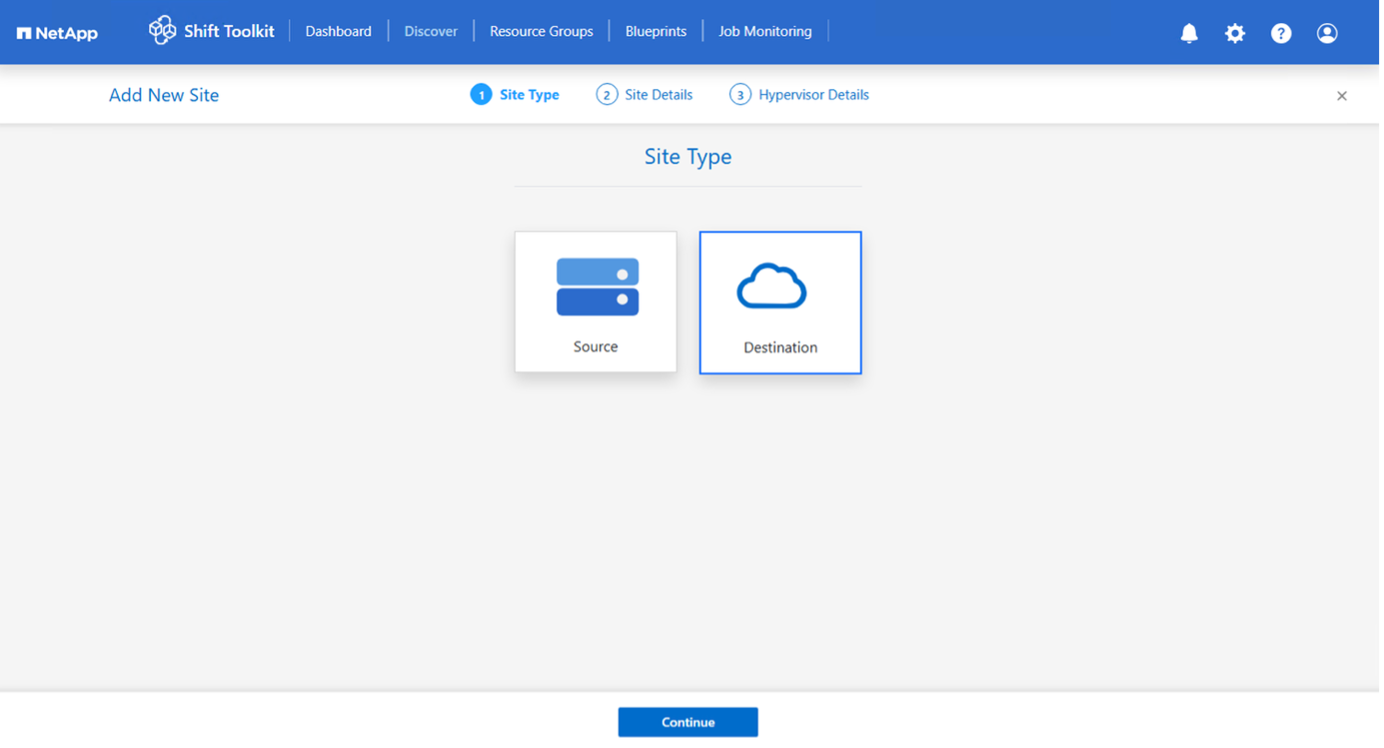
-
Enter the destination site details:
-
Site Name: Provide a name for the site
-
Hypervisor: Select OpenShift
-
Site Location: Select the default option
-
Connector: Select the default selection
-
-
Click Continue.
Show example
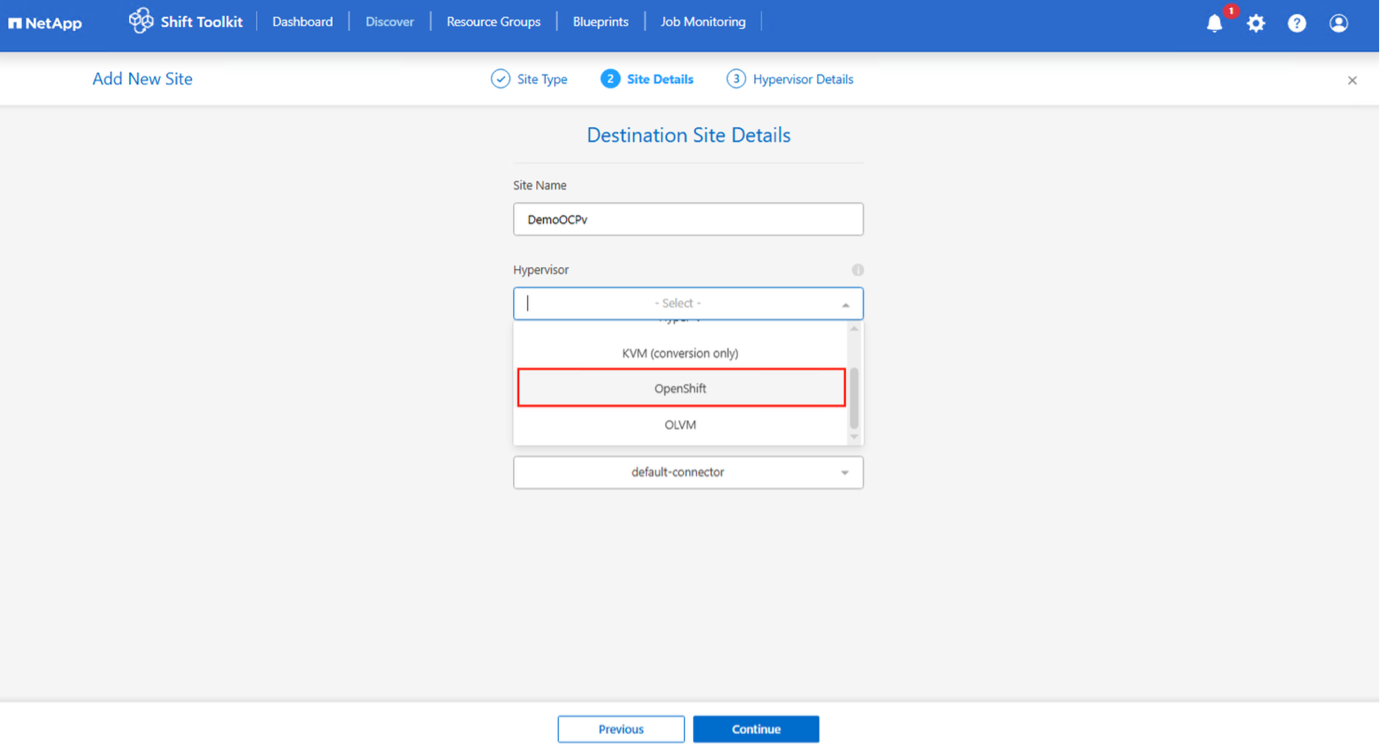
-
Enter the OpenShift details:
-
Endpoint: FQDN of OpenShift Cluster endpoint (for example, api.demomigsno.demoval.com)
-
Upload Kubeconfig file: Use the kubeconfig file with minimal permissions
The file extension must be yaml. Show example

-
-
Click Create Site.
Show example
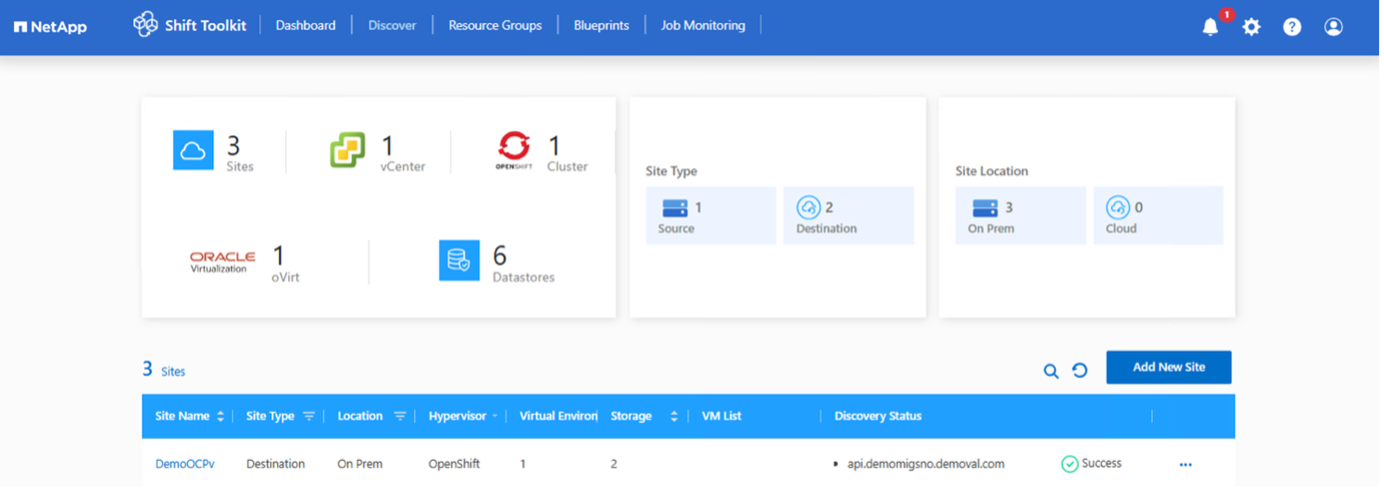
The source and destination volume will be the same as the disk format conversion happens at the volume level within the same volume.
Step 2: Create resource groups
Organize VMs into resource groups to preserve boot order and boot delay configurations.
Ensure VM VMDKs are moved to individual datastore volumes on a newly created ONTAP SVM.
-
Navigate to Resource Groups and click Create New Resource Group.
-
Select the source site from the dropdown and click Create.
-
Provide resource group details and select the workflow:
-
Clone based Migration: Performs end-to-end migration from source to destination hypervisor
-
Clone based Conversion: Converts disk format to the selected hypervisor type
-
-
Click Continue.
-
Select VMs using the search option.
VM selection for resource groups is based on virtual machine and not at the datastore level. Show example
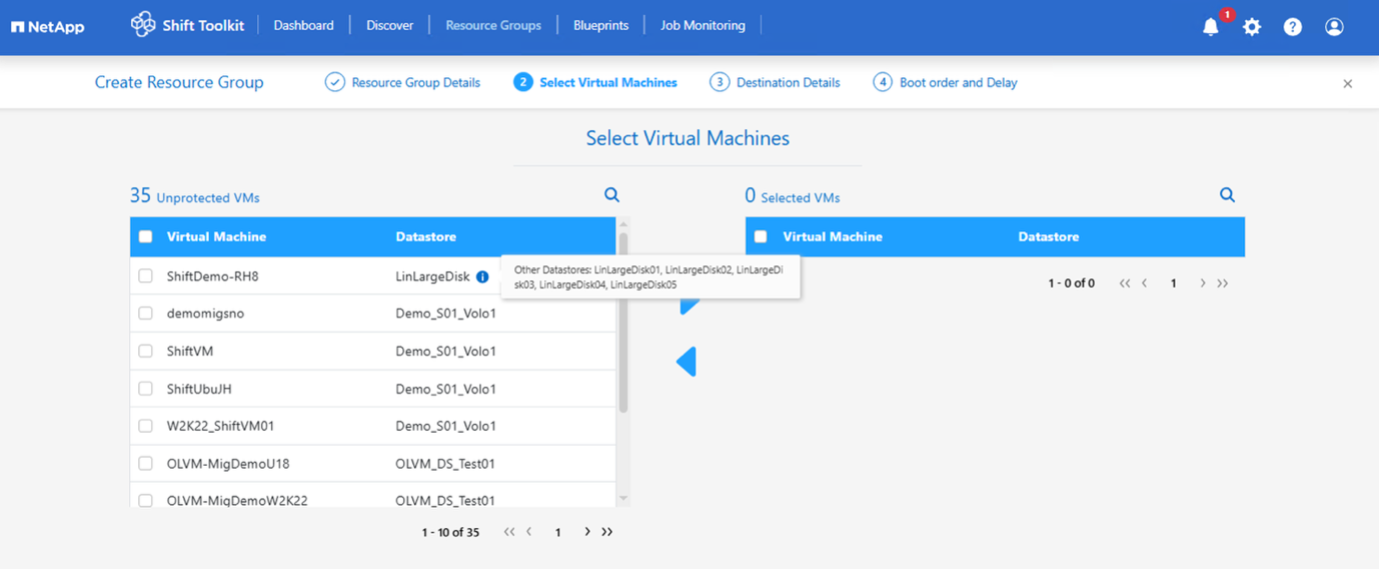
Show example

-
Update migration details:
-
Select Destination Site
-
Select Destination OpenShift entry
-
Select the storage class
Show example
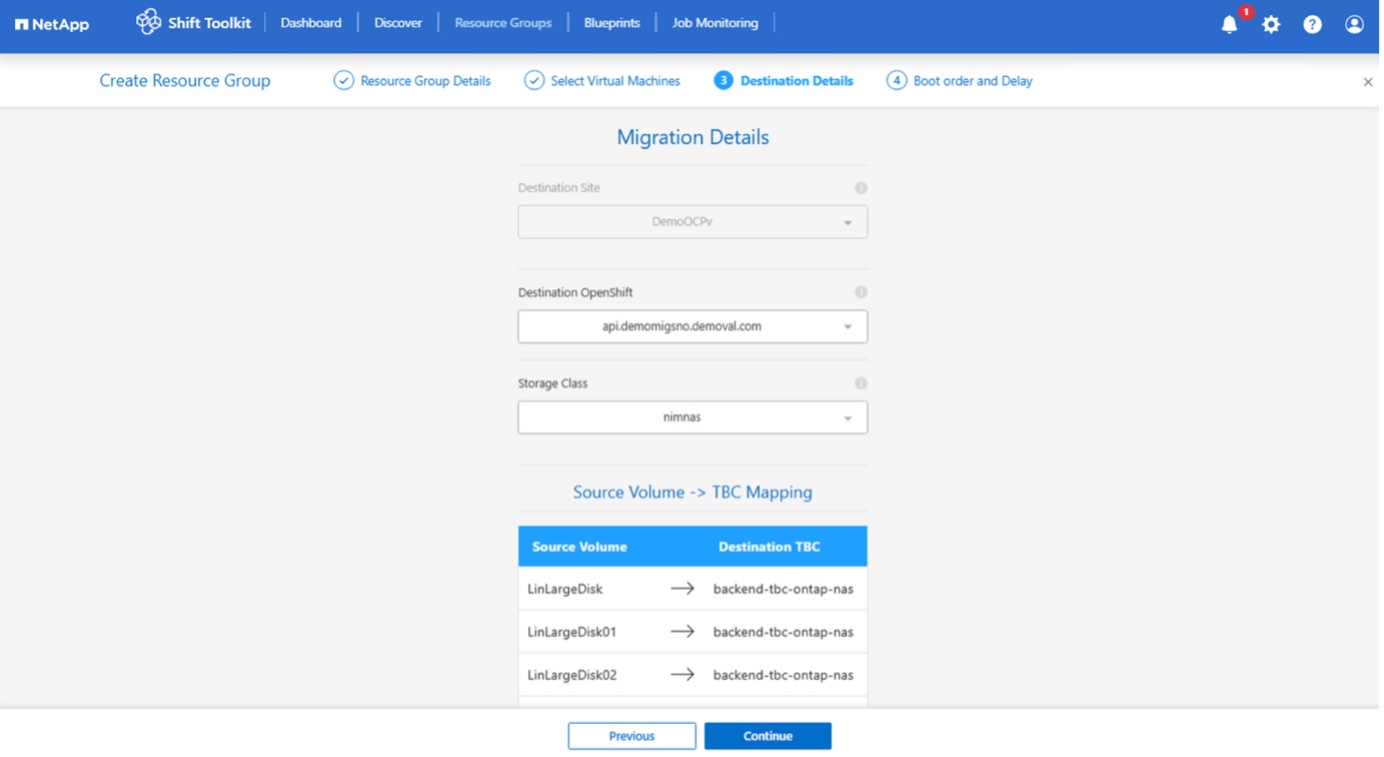
The Trident backend will be mapped to the source volume automatically if there is only one TBC; however, if there are multiple TBCs, the backend can be selected.
-
-
Configure boot order and boot delay for all selected VMs:
-
1: First VM to power on
-
3: Default
-
5: Last VM to power on
-
-
Click Create Resource Group.
Show example

The resource group is created and ready for blueprint configuration.
Step 3: Create a migration blueprint
Create a blueprint to define the migration plan, including platform mappings, network configuration, and VM settings.
-
Navigate to Blueprints and click Create New Blueprint.
-
Provide a name for the blueprint and configure host mappings:
-
Select Source Site and associated vCenter
-
Select Destination Site and associated OpenShift target
-
Configure cluster and host mapping
Show example

-
-
Select resource group details and click Continue.
-
Set execution order for resource groups if multiple groups exist.
-
Configure network mapping to appropriate logical networks.
Network attachment definitions should already be provisioned within the OpenShift cluster with the appropriate VLAN and trunk options. For test migration, select "Do not configure Network" to avoid production network conflicts; manually assign network settings after conversion. Show example
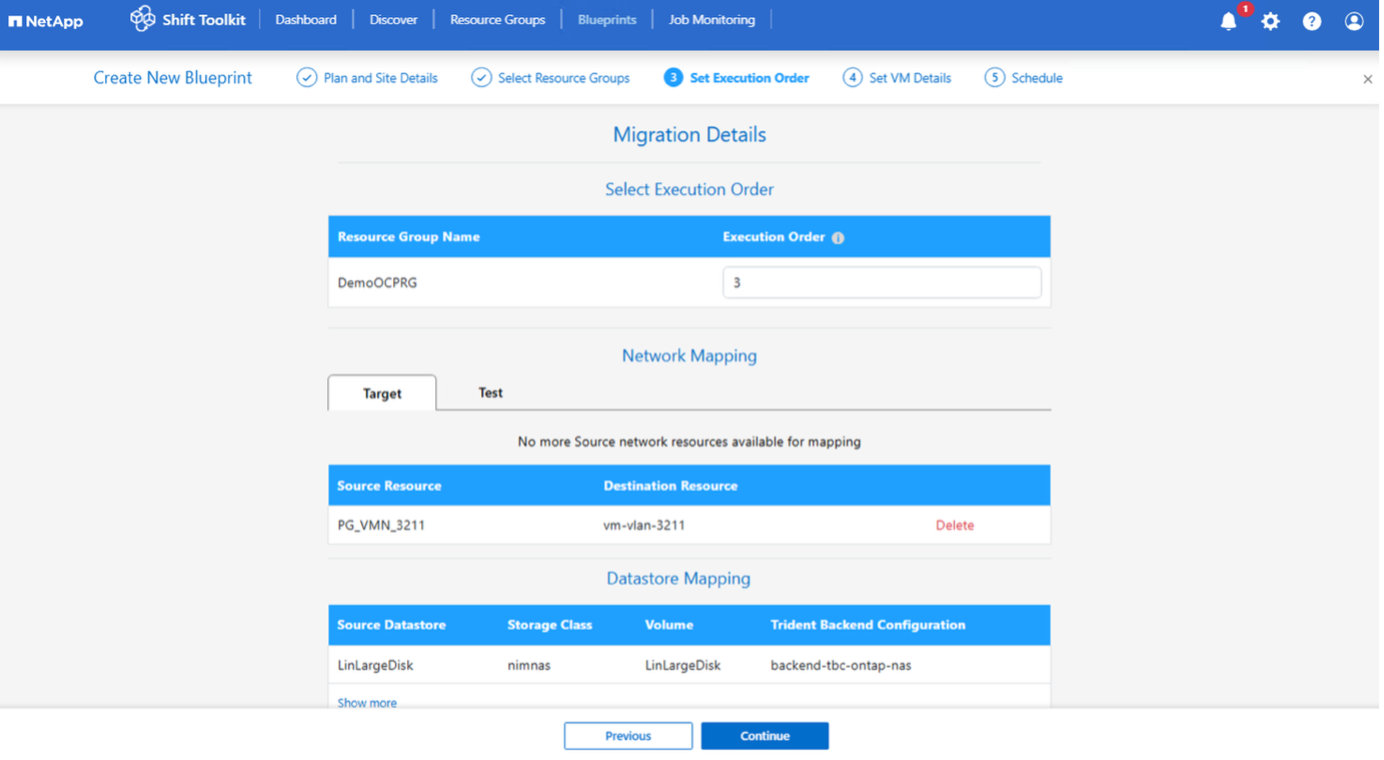
-
Review storage class and backend mappings (automatically selected based on VM selection).
Ensure VMDKs are svmotioned to individual volumes beforehand so the virtual machine can be created and powered on from the PVC. -
Under VM details, select configuration details and provide service account credentials for each OS type:
-
Windows: Use a user with local administrator privileges (domain credentials can also be used)
-
Linux: Use a user that can execute sudo commands without password prompt
Show example

The configuration selection allows you to select the disk image format, skip override prepareVM, and choose whether to split the volume from the parent. By default, split clone is disabled and the workflow defaults to RAW format.
-
-
Configure IP settings:
-
Do not configure: Default option
-
Retain IP: Keep same IPs from source system
-
DHCP: Assign DHCP on target VMs
Ensure VMs are powered on during prepareVM phase and VMware Tools are installed.
-
-
Configure VM settings:
-
Resize CPU/RAM parameters (optional)
-
Modify boot order and boot delay
-
Power ON: Select to power on VMs after migration (default: ON)
-
Remove VMware tools: Remove VMware Tools after conversion (default: selected)
-
VM Firmware: BIOS > BIOS and EFI > EFI (automatic)
-
Retain MAC: Keep MAC addresses for licensing requirements
If interface name needs to be retained while retaining the MAC address, ensure appropriate udev rules are created on the source VM. -
Service Account override: Specify separate service account if needed
-
-
Click Continue.
-
(Optional) Schedule the migration by selecting a date and time.
Schedule migrations at least 30 minutes ahead to allow time for VM preparation. -
Click Create Blueprint.
The Shift Toolkit initiates a prepareVM job that runs scripts on source VMs to prepare them for migration.
Show example

The preparation process:
-
Injects scripts to update VirtIO drivers, install qemu-agent, remove VMware tools, backup IP details, and update fstab
-
Uses PowerCLI to connect to guest VMs (Linux or Windows) and update VirtIO drivers
-
For Windows VMs: Stores scripts in
C:\NetApp -
For Linux VMs: Stores scripts in
/NetAppand/opt

|
For any supported VM OSes, the Shift Toolkit automatically installs necessary VirtIO drivers before disk conversion to ensure successful boot after conversion. |
When prepareVM completes successfully, the blueprint status updates to "PrepareVM Complete." Migration will now happen at the scheduled time or can be started manually by clicking the Migrate option.
Show example

Show example
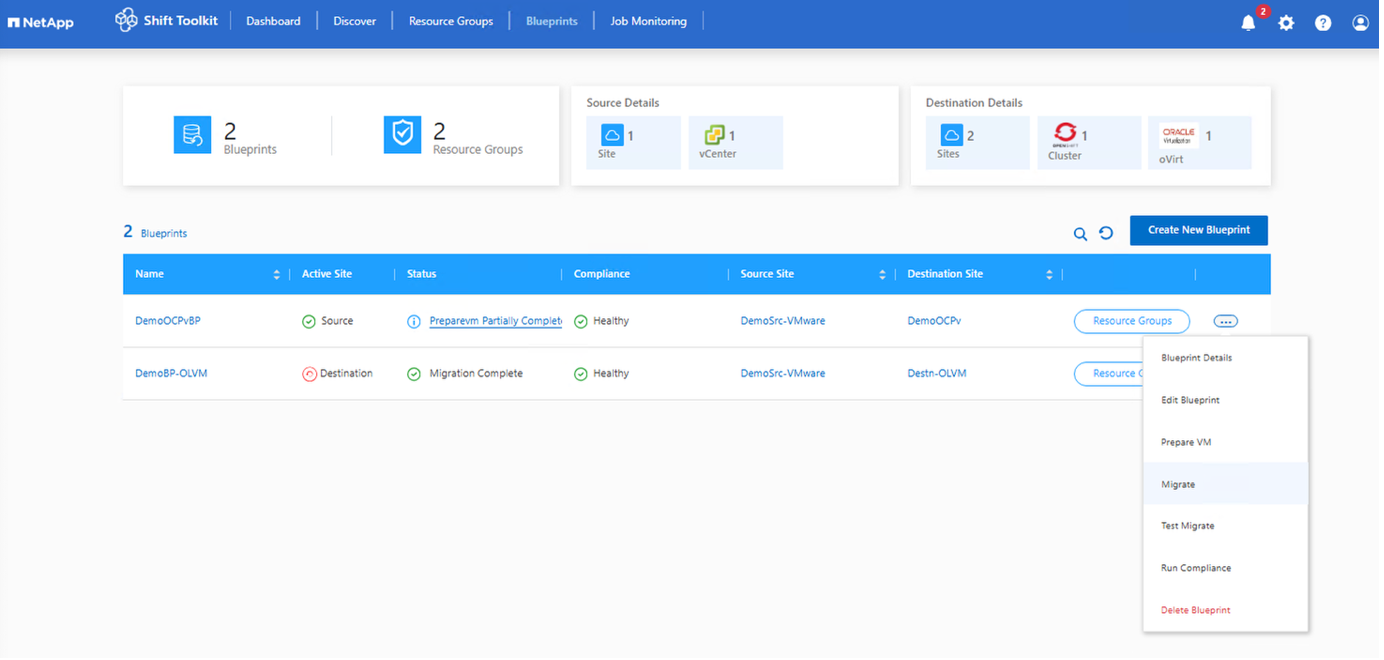
Step 4: Execute the migration
Trigger the migration workflow to convert VMs from VMware ESXi to OpenShift Virtualization.
All VMs are gracefully powered off according to the planned maintenance schedule.
-
On the blueprint, click Migrate.
Show example
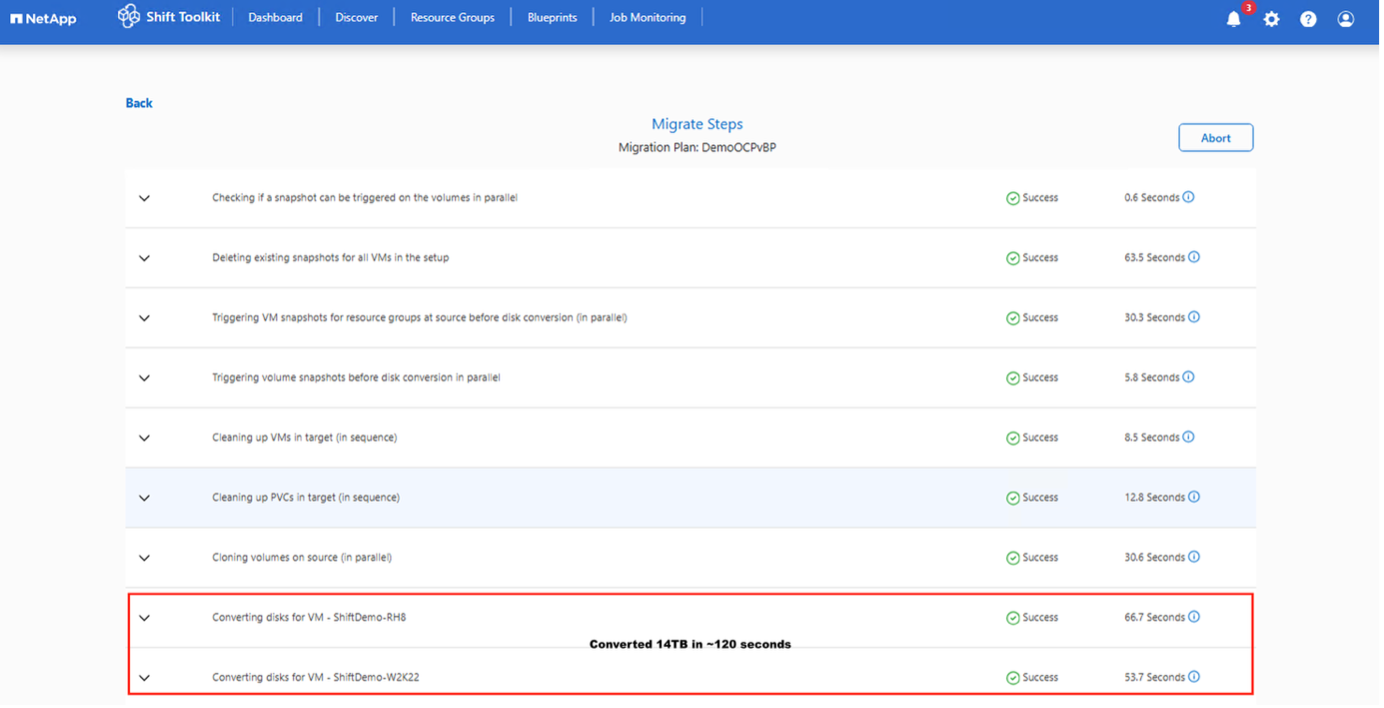
-
The Shift Toolkit performs the following steps:
-
Deletes existing snapshots for all VMs in the blueprint
-
Triggers VM snapshots at the source
-
Triggers volume snapshot before disk conversion
-
Clones the individual volumes
-
Converts VMDK to RAW format for each VMDK
The Shift Toolkit automatically finds all VMDKs associated with each VM, including the primary boot disk.
-

|
If there are multiple VMDK files, each VMDK will be converted. In this release (v4.0), each VMDK should be placed on an individual volume/datastore. |
-
Cleans up the volumes to have just the disk.img file
With the virtual machine disk image converted to RAW format, the Shift Toolkit cleans up the volumes, renames the raw file to disk.img, and assigns necessary permissions.
-
Imports the volumes as PVCs using Trident import
The volumes are then imported as PVCs using NetApp Trident APIs.
-
Creates VMs using VM-specific yaml files
Once the PVCs are imported and PVs are in place, the Shift Toolkit uses OC CLI to create each VM depending on the OS using yaml files.

|
VMs are created under the "Default" namespace. |
-
Powers on VMs at the target
Depending on the VM OS, the Shift Toolkit auto-assigns the VM boot option along with storage controller interfaces. For Linux distributions, VirtIO or VirtIO SCSI is used. For Windows, the VM powers on with SATA interface, then the scheduled script auto-installs VirtIO drivers and changes the interface to VirtIO.
-
Registers networks on each VM
Networks are assigned based on the blueprint selection.
-
Removes VMware tools and assigns IP addresses using cron jobs
Show example

Use Migration Toolkit for Virtualization with Shift Toolkit
This section describes how to use Migration Toolkit for Virtualization (MTV) with NetApp Shift Toolkit for seamless migration to Red Hat OpenShift Virtualization.
Ensure the following prerequisites are met:
-
OpenShift cluster with OpenShift Virtualization operator and NetApp Trident CSI driver installed
-
MTV 2.9.4 (which includes conversion mode)
-
Shift Toolkit installed
Since only Shift Toolkit API is used, there is no need to configure Shift Toolkit resource groups or blueprints. -
Administrator level privileges on the OpenShift cluster
-
A Linux instance with tridentctl and OC command line tool installed
-
Kubeconfig exported or OC login executed to connect to the cluster
-
Download the script named "OpenShift-MTV" from Shift Toolkit UI (Settings > Developer Access > Script Blocker)
-
Unzip the file:
unzip openshift-mtv.zip -
Ensure Python3 is installed:
dnf install python3 -
Install OpenJDK 8 or later:
yum install java-1.8.0-openjdk -
Install requirements:
pip install -r requirements.txt
-
-
Virtual Machine requirements for MTV: VMDKs for a VM must be placed on individual volumes. For a VM with 3 disks, each disk should be on its individual volume (mapping datastore to PVC construct). This must be done manually using storage vmotion.
-
Create migration plans using MTV.
To leverage fast VMDK conversion, create a migration plan for the VMs and ensure the following parameters are in the YAML:
-
targetNamespace: default -
type: conversion -
storage: {}The plan should be created beforehand to ensure preserve IP settings are configured by MTV.
-
-
Map VMs from vCenter and volumes on ONTAP storage.
Use the script to create necessary PVCs and import them to the OpenShift cluster. The PVCs must have the following labels and annotations:
Labels:
-
vmID and vmUUID in the PVC (Forklift looks for these values)
Annotation:
-
The vmdk disk name for
forklift.konveyor.io/disk-sourceThe script ensures these attributes are set for every PVC and updates disk.img permissions:
-
"owner": { "id": 107 } -
"group": { "id": 107 } -
"mode": "0655"
-
-
Update the JSON file with the following details:
-
ONTAP Cluster: Can be a SVM; vsadmin can be used. Set splitclone to "False" if clone volume doesn't need immediate detachment
-
vCenter: Minimum RBAC rights to discover VMs and associated VMDK files
-
Trident storage class: Should be NFS backend with correct version in yaml
-
OpenShift: Specify the project name (default is used as an example)
Keep the rest of the values as default.
-
-
Once prerequisites are met, execute
python3 main.pyto create PVCs and import them to the OpenShift Cluster. -
Once PVCs are imported, trigger migration using MTV to create the VM with the appropriate specification.
Show example
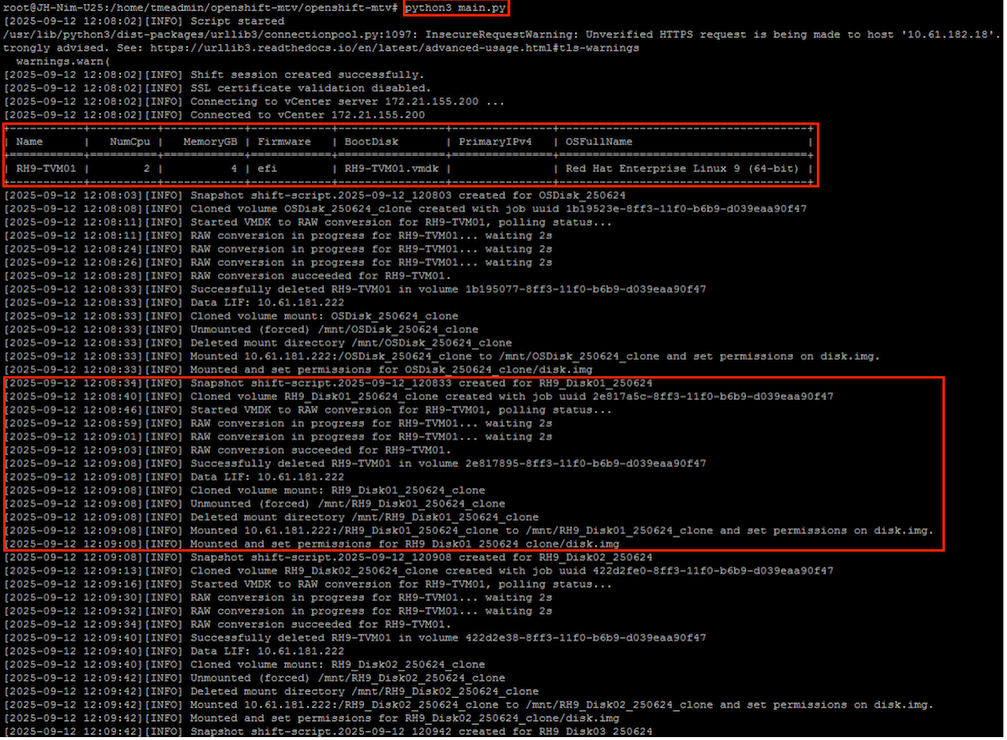
Show example

-
Convert VMDK with MTV.
The script automatically finds all VMDKs associated with each VM, including the primary boot disk.
If there are multiple VMDK files, each VMDK will be converted. -
Upload RAW image to OpenShift Virtualization.
The script uses Trident CSI to import volumes as PVCs to the cluster. The PVC yaml is populated with labels and annotations.
-
Create virtual machine with MTV.
After import, call the MTV plan to start migration. The UI shows as "Cold," but based on the yaml specification of conversion, MTV checks for each PVC and the vmID/vmUUID, maps them, and initializes the migration.
Show example

VMs are created under "Default" project for virtual machines, but this can be modified within the MTV migration plan YAML. -
Boot VM for the first time with MTV.
Depending on the VM OS, MTV auto-assigns the VM boot option along with storage controller interfaces.
Show example

Migration completed in 6 minutes for a VM with 1.5TB data disk (spread across 3 PVCs). This showcases a streamlined, low-impact approach to re-homing VMs using ONTAP storage.
Before getting started with this specific integration, contact your Red Hat account team.
Video demonstration
The following video demonstrates the process outlined in this solution.


